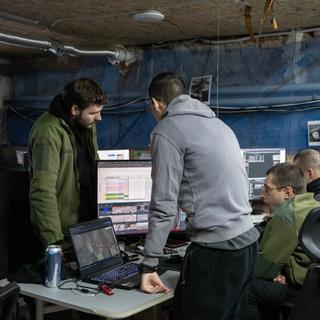


War in Ukraine: In the Donbas, a regiment pioneers new forms of drone warfare
NewsUkraine's 'Madyar Birds' regiment is tasked with using drones to locate and destroy Russian invaders and their equipment.
Somewhere in Donbas lies a vast complex of underground halls housing the "Madyar Birds," a unique Ukrainian regiment. It is composed of a few thousand men and women tasked with clearing the skies of Russian drones and relentlessly destroying the invader's men and equipment with drones. Situated in an undisclosed location, this is the HQ of Robert Brovdi, known by the nickname "Madyar" (Magyar, "the Hungarian," in Ukrainian), commander of the 414th detached regiment of unmanned combat systems.
Dressed head to toe in black, 49-year-old Brovdi doesn't share the foul mood of many Ukrainian servicemen worn down by nearly three years of war. If things are going badly on the front, it's due to "the impotence of our Western partners, who helped us at the start, but didn't speed up their arms production and are now afraid that Putin will press the red button." Determined to continue the fight, "Madyar" is hard at work perfecting the new art of drone warfare.
He gave Le Monde a tour of the regiment's HQ. One room was dedicated to the hunt for enemy drones. These fall into two main categories: reconnaissance drones (RD) and combat drones (CD). In the summer of 2024, the former became one of the main threats, because their cameras transmit to Russian artillery, in real-time, precise coordinates of Ukrainian military positions up to several dozen kilometers behind the front line.

In the room, a man and two women sat facing very large screens, making frequent phone calls. "Madyar" played several videos of in-flight destruction of these RDs by "ram drones" on a screen, tasked with hitting their targets until they fall. "We use quadrotors up to 2,000 meters and fixed-wing drones up to 4,000 meters," explained "Madyar," very proud that his team had developed ram drones, often reusable and costing a few thousand euros, to shoot down DRs priced between €200,000 and €300,000 each.
'Our dome system is unique'
Combat drones can be divided into two sub-categories: bombers and FPVs (first-person view). These very inexpensive quadrotors have been proliferating on the battlefield since 2023, causing half of all human and material losses. Engineers at the 414th regiment have developed an electromagnetic intelligence system (ROEM) dubbed "Koulibine," which intercepts the enemy drone's video signal (used to guide the drone) in real-time. The screen displays the image seen by the Russian pilot, enabling the "Madyar Birds" to pinpoint the pilot's exact location. This is when the jammer network of the 414th comes into play. By cutting off the drone's piloting frequency, it causes the quadrotor to fall without being able to reach its target.
You have 66.5% of this article left to read. The rest is for subscribers only.
